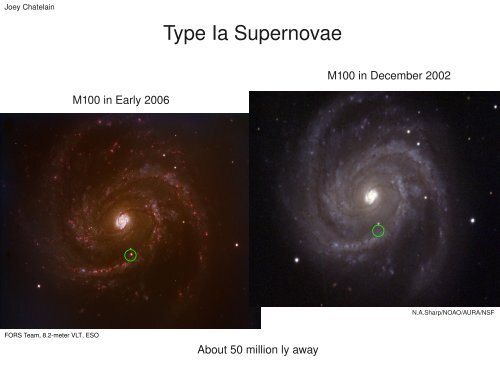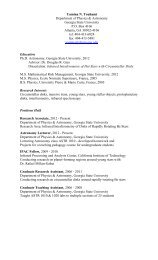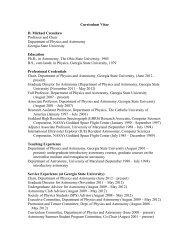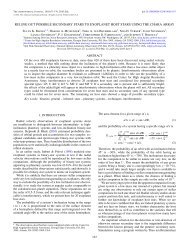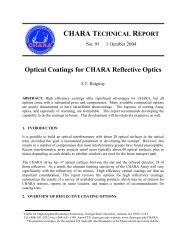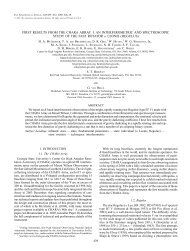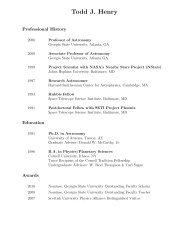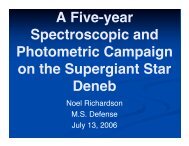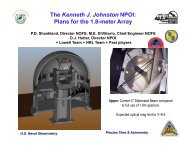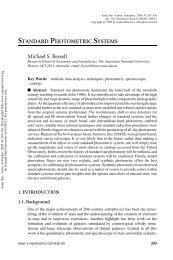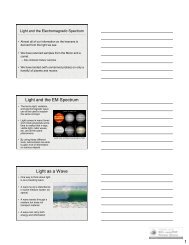Type Ia Supernovae
Type Ia Supernovae
Type Ia Supernovae
You also want an ePaper? Increase the reach of your titles
YUMPU automatically turns print PDFs into web optimized ePapers that Google loves.
Joey Chatelain<br />
<strong>Type</strong> <strong>Ia</strong> <strong>Supernovae</strong><br />
M100 in December 2002<br />
M100 in Early 2006<br />
N.A.Sharp/NOAO/AURA/NSF<br />
FORS Team, 8.2meter VLT, ESO<br />
About 50 million ly away
Contents:<br />
● Historical <strong>Supernovae</strong><br />
● Supernova Taxonomy<br />
● Causes of Supernova<br />
● <strong>Type</strong> <strong>Ia</strong> Sn as a Standard Candle<br />
● Useful Range of <strong>Type</strong> <strong>Ia</strong> Sn<br />
● Issues with using <strong>Type</strong> <strong>Ia</strong> Sn<br />
● Resolutions to these issues<br />
● “Recent” results
History of Sn<br />
Tycho's Supernova remnant:<br />
<strong>Type</strong> <strong>Ia</strong> Supernova recorded in 1572<br />
Was said to be nearly the brightness<br />
of Venus in the night sky.<br />
Supernova have been observed and<br />
recorded within the MW for thousands<br />
of years<br />
Year Date Con mag Remnant Observed/Comments<br />
352 BC ? Chinese<br />
4 BC spring Aql Chinese<br />
185 AD Cen -2 G315.4-2.3 Chinese<br />
369 ? Chinese<br />
386 Sgr G11.2-0.3? Chinese<br />
393/396 Sco -3 SNR 393 Chinese<br />
437 ? Gem<br />
827 ? Sco/Oph -10<br />
902 ? Cas 0<br />
1006 Apr 30 Lup -9+-1 SNR 1006 Arab,Chinese,Japan,Euro<br />
1054 Jul 4 Tau -6 M1 Chinese,also Arab, Japan<br />
1181 Aug 6 Cas -1 3C 58 Chinese and Japanese<br />
1203 ? Sco 0<br />
1230 ? Aql<br />
1572 Nov 6 Cas -4 Tycho SNR Tycho Brahe's SN<br />
1592 ? Cet Korean; probably Nova<br />
1592 ? Cas Korean; probably Nova<br />
1592 ? Cas Korean; probably Nova<br />
1604 Oct 9 Oph -3 Kepler SNR Johannes Kepler's SN<br />
1680? 1667? Cas Cas A Flamsteed ? not seen ?<br />
Michael Richmond, 2009<br />
Xray: NASA/CXC/SAO; Infrared: NASA/JPLCaltech; Optical: MPIA, Calar Alto, O. Krause et al.
Supernova Taxonomy
Spectra can form P Cygni Profiles<br />
due to expanding Shells<br />
Note Hydrogen<br />
absorption<br />
(Fillipenko 1997)<br />
Note that <strong>Type</strong> <strong>Ia</strong> are conveniently<br />
the brightest of the Supernova<br />
allowing them to serve as our<br />
deepest probes.
What causes different types?<br />
<strong>Type</strong> <strong>Ia</strong><br />
Exploding White Dwarf<br />
<strong>Type</strong> Ib/c<br />
Exploding WR Star<br />
<strong>Type</strong> II<br />
Exploding Massive Star<br />
NASA, ESA, J. Hester, A. Loll (ASU);
<strong>Type</strong> <strong>Ia</strong> as standard candles<br />
Sandage found M V<br />
(max) = 19.92+/ .13<br />
and M B<br />
(max) = 19.74+/ .24<br />
using Cepheid Calibration in 1992<br />
Now use Distance modulus equation:<br />
0.2(m− M+ 5)<br />
d = 10
Range of <strong>Type</strong> <strong>Ia</strong> Sn<br />
Works out to 3000 Mpc w/ 810% accuracy<br />
One of the most distant Sn ever detected,<br />
Sn1997ff was detected by the Hubble Deep<br />
Field in a galaxy nearly 3000 Mpc from Earth.<br />
Overlap with cepheids<br />
Sn1994D in NGC 4526.<br />
NGC 4526 is only 17 Mpc away. Cepheid<br />
measurements have been made in NGC<br />
4639 which is nearly 22Mpc distant.
Problems with using <strong>Type</strong> <strong>Ia</strong> Sn as Standard Candles<br />
Relative: Still based on some<br />
external calibration, Usually<br />
FaberJackson, TullyFisher,<br />
or Cepheids.<br />
Unpredictable: We<br />
never know when or<br />
where a Super nova will<br />
occur, thus we can often<br />
miss peak brightness,<br />
which is the primary<br />
means of calibration.<br />
Not actually all Identical:<br />
Both subLuminous and overluminous<br />
<strong>Type</strong> <strong>Ia</strong> Sn have<br />
been seen. Varying by as<br />
much as .8 mag.
Overcoming these problems<br />
M V max =−9.96−2.31logṁ<br />
During 1 st 15 days<br />
Supernova surveys<br />
˙<br />
M.M.Philips<br />
Joshua A. Frieman
Recent results<br />
Final results from Hubble Space telescope<br />
Key Project to measure Hubble Constant<br />
Freedman et al. 2000<br />
Found H 0<br />
=71 +/ 2 r<br />
+/ 6 s<br />
using <strong>Type</strong> <strong>Ia</strong> Sn<br />
Supernova Cosmology Project<br />
Knop et al. 2003<br />
Used several high redshift Sn to constrain<br />
Quantities for Cosmological constants
Sources<br />
Picture References<br />
1.) http://rsdwww.nrl.navy.mil/7212/montes/snetax.html<br />
2.) http://www.lbl.gov/ScienceArticles/Archive/sabl/2005/October/04supernovae.html<br />
3.) http://www.pha.jhu.edu/~bfalck/SeminarPres.html<br />
4.) http://www.pha.jhu.edu/~qzhang/seminar1bfigs/node2.html<br />
5.) http://dujs.dartmouth.edu/wpcontent/uploads/2008/05/picture16.png<br />
6.) http://antwrp.gsfc.nasa.gov/apod/ap091025.html<br />
7.) http://cfcp.uchicago.edu/research/highlights/highlight_20060115.html<br />
8.) http://stupendous.rit.edu/richmond/answers/historical.html<br />
9.) http://www.astrosurf.com/btatlas/n4639.htm<br />
References<br />
1.) Phillips, M. M. 1993<br />
2.) Sandage et al. 1992<br />
3.) Branch, D. 1992<br />
4.) Freedman et al. 2000<br />
5.) Binney and Merrifield 1998<br />
6.) Carroll and Ostlie 1996
Wolf Rayet Star is a star that has blown off outer shells of gas.<br />
This is a basic step in massive star evolution, and a star that has<br />
successfully blown off all Hydrogen will become a <strong>Type</strong> Ib<br />
supernova while a star that has blown off all of its He shells as<br />
well will explode as a type Ic.<br />
P Cygni profile is a blueshifted Absorption line followed<br />
by a broad emission line with redshifted slope. This is<br />
characteristic of many massive stars that are sloughing<br />
off material (usually Hydrogen and Helium, but with Sn it<br />
can be a plethora of elements) due to radiation pressure.<br />
The feature is caused by an expanding mass shell that is<br />
mainly emitting, but is absorbing light from the central<br />
source (or inner mass shells) directly in the line of site,<br />
thus the blueshift.
What causes Sn Light curve Shapes? The initial<br />
shell is optically thick, so the initial outburst is not<br />
seen. However when the shell expands far enough<br />
The shell becomes optically thin, and the sharp rise<br />
is seen. After initial peak, radioactive nickel serves<br />
as the primary heat source, and the initial steepness<br />
of the downward slope is caused by the short half<br />
life of Ni(56) which is about 6 days. The Second<br />
more shallow slope is caused by Cobalt(56) decay<br />
into Iron which has a half life of about 77 day.


